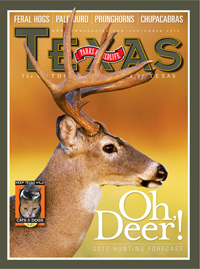
Wild Thing: Bold Jumper
Acute vision and athleticism make this spider a catlike hunter.
By Sheryl Smith-Rogers
Two summer years ago, my husband, James, and I were discussing job-related frustrations over supper when suddenly he pointed across the table. “Look!” he exclaimed.
I followed his gaze to the top of an empty dining chair. There perched a bold jumping spider, her large front eyes intently focused on James like she’d been absorbing everything he’d said. I laughed.
That’s a Phidippus audax for you. Curious, outgoing, fearless even (and relatively harmless to humans), the fuzzy black jumping spider with white markings ranks as my favorite among Texas’ nearly 900 spider species. Their iridescent blue or green chelicerae (jaws), which are sometimes mistaken for eyes, conceal curved fangs that inject venom into prey.
Among spiders, salticids have the sharpest vision. I once saw a jumping spider turn to watch a car pass by. That happened because one of six secondary eyes arranged on the spider’s head detected motion. Then the spider swiveled around and focused its large primary eyes on the car.
But not for long. Potential meals matter more to a jumping spider, which can leap many times it own body length. That amazing ability coupled with acute vision enables these daytime hunters — at home both indoors and out — to pounce on insects and other spiders with true catlike finesse.
Naturally, such daring jumpers don’t always hit their mark. No problem. As they move about, salticids leave behind a silken dragline for climbing back up when needed. They also use silk to construct nests on leaves, under debris and in other sheltered hideaways. The cocoons provide a safe place to molt (spiders grow by shedding their exoskeleton skin), hibernate, rest and lay eggs.

